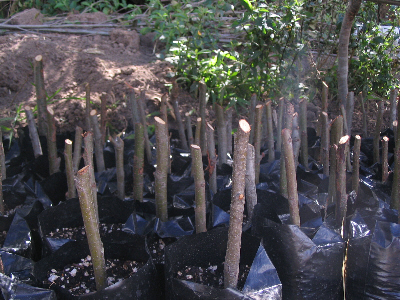Podcast: Play in new window | Download
Subscribe: RSS
Carbon Into Trees
By Jennifer Moore
Stuart Franklin is turning air miles into trees.
Franklin — the founder of a grassroots carbon offsetting project in Ecuador called CanopyCo — calculates how many seedlings he has to put in the ground in order to generate a carbon bank big enough to capture the carbon dioxide emitted by airplanes carrying tourists from the Ecuadoran mainland to the popular Galapagos Islands each year.
But it’s easier said than done calculating how many trees it takes to offset a ton of carbon, since different species sequester different quantities of carbon depending on local conditions such as soil composition and microclimate. Stuart figures that it takes about 1.2 to 1.25 trees to offset the emissions from a flight from mainland Ecuador to the national park and marine reserve.
Planting trees since 2008, CanopyCo already has partnerships with a number of travel operations in Quito, the national tourist hub.
As a growing industry, it makes sense to businesspeople like Jim Wilson that travellers should put a little bit back into Ecuador’s environment. Currently, his company offsets the operation of their luxury cruise ship on the Galapagos, as well as their employees’ travel to and from work, in order to build greater climate change awareness amongst their staff.
Jim is hopeful that the idea will catch on with more agencies and become part of every traveller’s plan when they go abroad.
However, CanopyCo is not just planting x number of trees to offset x tons of carbon. Rather, they are turning tourist dollars into natural forest regeneration. Working cooperatively with local community members, they have begun in the highland farming community of Peribuela.
Small farmers, or campesinos, make up about 70 percent of Ecuador’s rural work force and are some of the hardest hit by climate change. From one rolling expanse of the Andes to the next, their experiences of climate change ranges from more frequent inundations to greater risk of drought.
Local farmer Don Geronimo hopes that by regenerating forest, which still retains important hardwood species such as the Watzi tree, that their community of sixty families will benefit in multiple ways. Protection against soil erosion, reforestation of their water catchment area, development of a tree nursery to provide native species for the reforestation project as well as commercially important fruit trees for their farms are just a start. More forest cover, Don Geronimo believes, will also be good for their local eco-tourism initiative.
Involving international volunteers in their tree planting work bees also gives their tourist services a boost and provides an opportunity for hands-on environmental education.
Most importantly, Don Geronimo’s project enables him to keep tabs on the carbon he’s actually fixing. A 2005 report for the World Rainforest Movement and the Quito-based environmental organization Acción Ecológica reveals why this is so important.
In the 1990s, an international foundation began a monoculture tree plantation program in Ecuador with original financing from a coal-fired electricity generation plant in Europe. It later started to raise funds independently through carbon credit trading.
But it turned out to be more of a sink for money than for carbon.
The foundation signed contracts with several dozen communities to plant predominantly pine tree plantations across the highlands and parts of the coast. Pine is not native to Ecuador and dries out sensitive high altitude wetlands, called páramo, in which many of the trees were planted. The páramo actually stores a great deal of carbon, but this capacity greatly diminishes when damaged. As a result, one investigator has concluded that the carbon balance of this particular project may be negative.
Nor did this project deliver promised benefits for local communities. Anticipating long term jobs and thousands of dollars, communities got stuck in unfavorable contracts, received far less money than expected and had to rely on expensive technical expertise to establish the plantations, while the foundation gained rights to communal land. Long before plantations were supposed to fulfill their carbon sequestering role, maintenance costs became unviable for communities in at least several cases that have been examined.
CanopyCo is a much smaller project whose trees are still young. But the line between carbon-spent and carbon-captured is clear and grounded on other principles. With little overhead and a commitment to ecological restoration and local capacity building, Peribuela is seeing benefits. Neighboring communities are already lined up to replicate their experience.![]()






There are no comments
Add yours